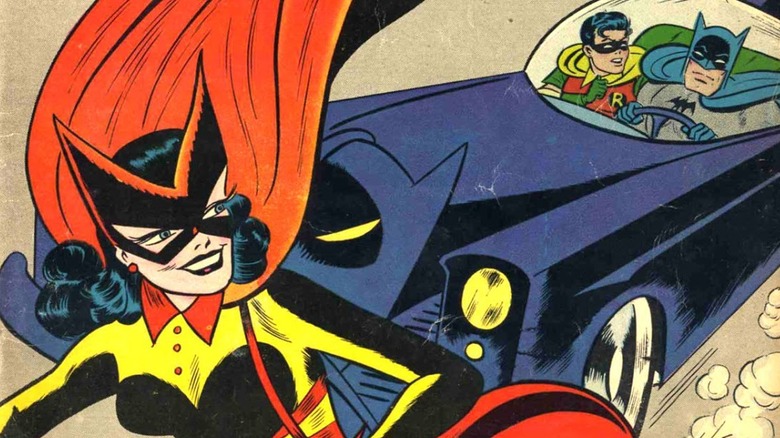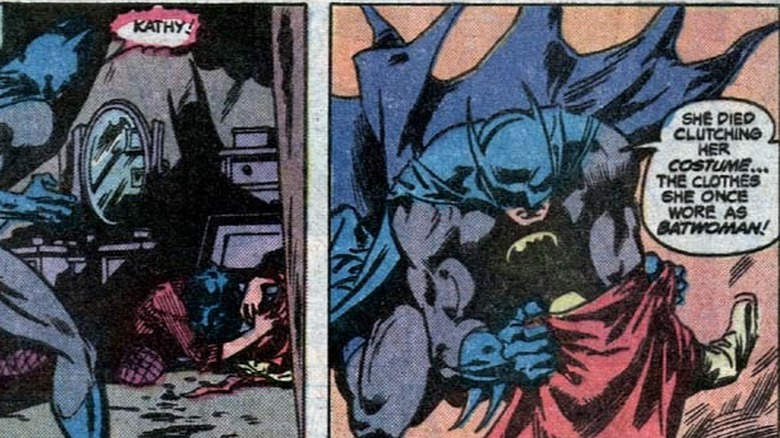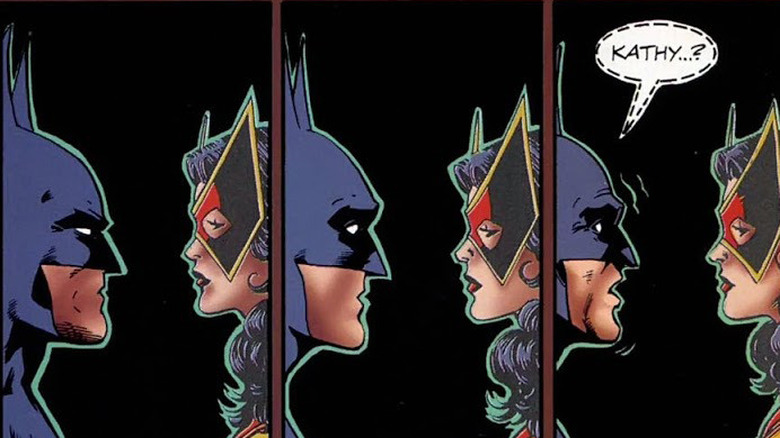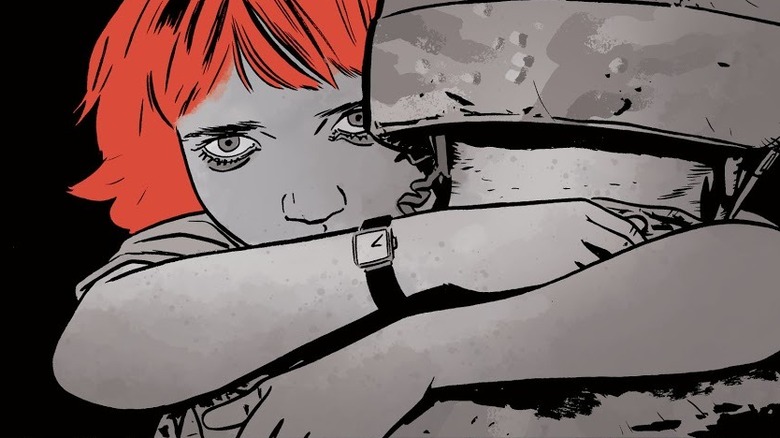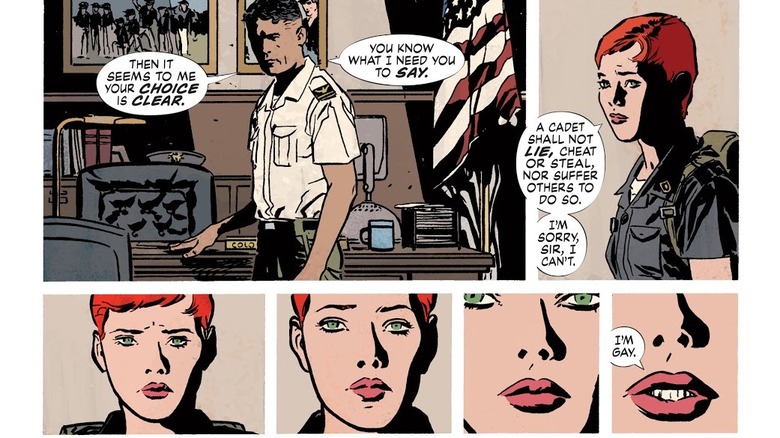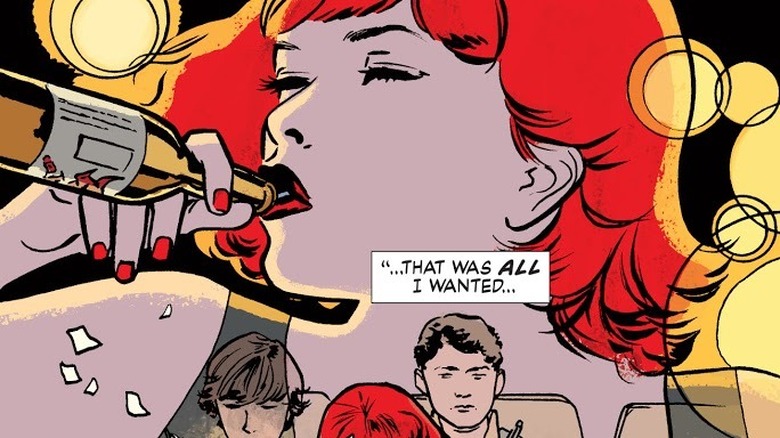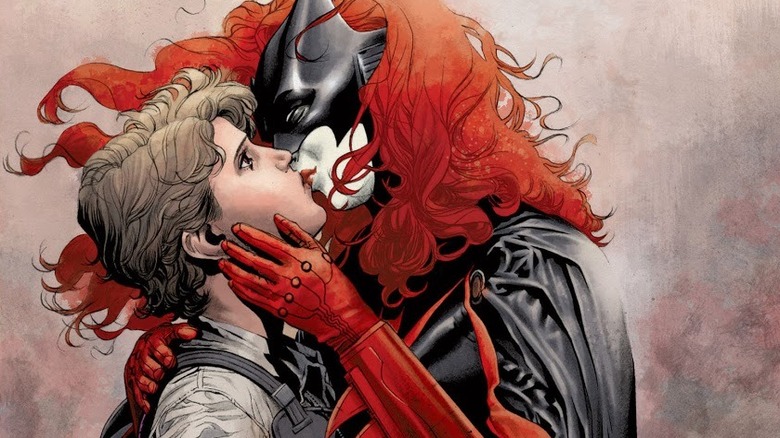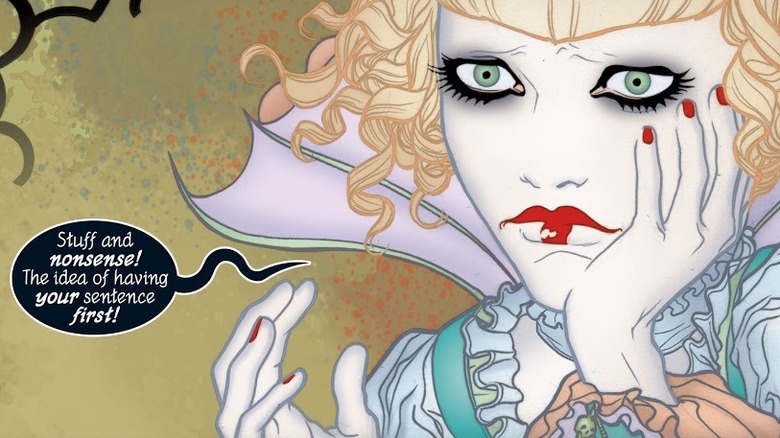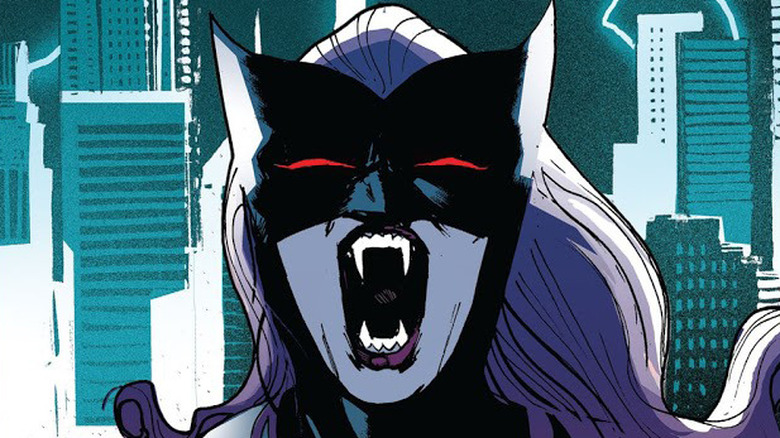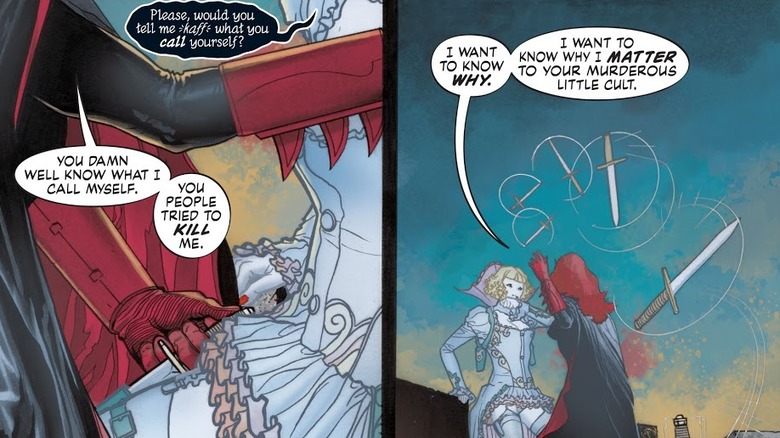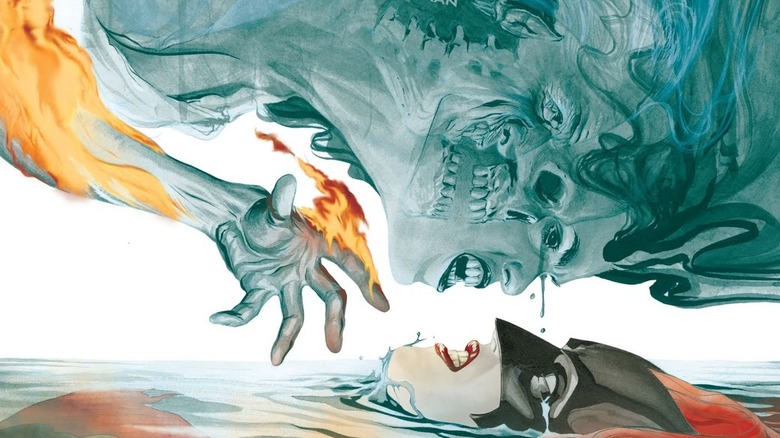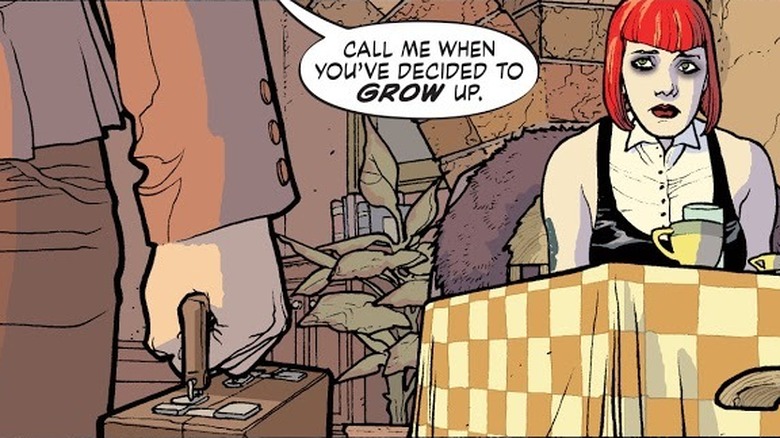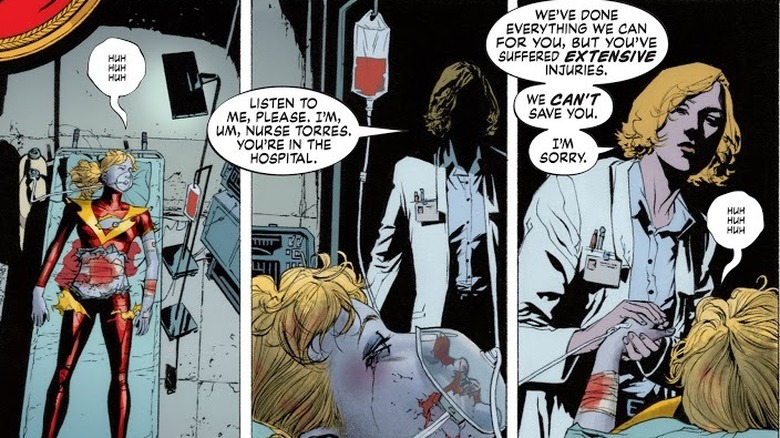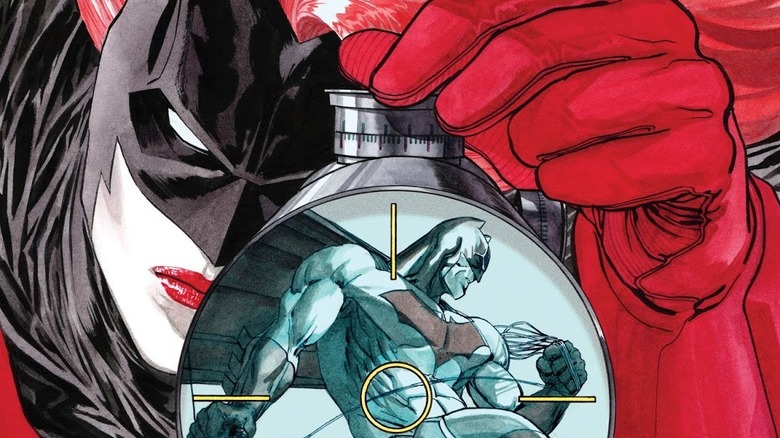The Dark History Of Batwoman
Batwoman has one of the most unique histories in comics. Her story begins in 1956, when Kathy Kane, the first Batwoman, burst onto the ink-and-paper landscape. Kathy is a fascinating combination of traditional femininity and daredevil antics. She totes a Bat-purse (yes, really) full of goofily weaponized cosmetics, yet she also boasts killer acrobatic and motorcycle skills. The second Batwoman, Kate Kane, rocketed to fame upon her 2006 debut. Her moniker and desire to fight crime appear, at first glance, to be just about the only things she has in common with Kathy, as Kate is a dedicated soldier, a proud lesbian, and a hard-nosed detective.
But if you look a bit closer, you can discern a thread connecting the women who've taken up the mantle of Batwoman. That thread is a dark one, woven from trauma and prejudice both on and off the page. Indeed, Batwoman's history is pockmarked with murder, substance abuse, bigotry, and loneliness. In some ways, she's an even more tragic figure than Batman himself. From Kathy Kane's roots in real-world oppression to Kate Kane's shredded family ties, this is the dark history of Batwoman.
Batwoman and the Lavender Scare
Batwoman made her debut in 1956's "Detective Comics" #233. Here, she's a spunky heiress named Kathy Kane, clad in a yellow bat-suit, heeled ankle boots, and dainty gloves. Her interest in superheroics is part thrill-seeking, part romance — she's got eyes for Batman, and she believes becoming a costumed crime-fighter is the best way to earn his attention.
Sounds like the silly, swoony stuff of the Silver Age, right? It is — but Batwoman also encapsulates a particularly dark moment in American history. In 1954, psychiatrist Fredric Wertham published "Seduction of the Innocent," an excoriation of what he believed to be comic books' disastrous effect on young people. Batman and Robin, the book alleges, constitute "a wish dream of two homosexuals living together." Two years later, in what was absolutely not a coincidence, Batwoman was born.
The anxiety created by Wertham's assertions is depressing unto itself, but the circumstances of Batwoman's creation are even darker when understood in the wider context of the era. The 1950s saw LGBTQ+ Americans persecuted in many ways, one of the most prominent being the Lavender Scare. The Scare was a moral panic stoked by Cold War-era fears about national subversion. LGBTQ+ people working in government were scapegoated as sources of communist infiltration, resulting in thousands of people losing their jobs, reputations, and sense of safety. Batwoman's silliness is very real, but so is the perniciousness of the climate which created her.
Kathy Kane meets her end
So, what happened to Kathy Kane of the Bat-purse and yellow unitard? Like so many cheesy elements of comics' awkward postwar period, she was put away like an outgrown toy. The first Batwoman was not, however, so minor a character as to disappear with zero explanation. Though she largely vanished from DC canon after 1964, the late 1970s saw something of a revival for the erstwhile heroine. Unfortunately, her return to the page didn't end well.
In 1979's "Detective Comics" #485, Kathy is enjoying quite the unique retirement. Since putting away her cape and cowl, she's become the owner of a circus. Unfortunately, the League of Assassins has decided to pay her operation a little visit, and Batman intends to find out why. Though she's troubled by the baddies who've darkened her doorstep, Kathy is delighted to see her old beau ... until a fresh group of fighters, led by the Bronze Tiger, enter the big top. After incapacitating Batman, the Tiger dispatches Kathy with a fatal slash of his knife. She manages to drag herself to her private quarters where she dies clutching her old costume.
There's something especially tragic about Kathy's end when one considers her beginning. Who could look at her sunshiny debut and imagine that her story would end in the blood-stained dirt? No wonder Batman swears, as the cover to this issue trumpets, a "vengeance vow" in her name.
The lonely ghost of Planet Krypton
Comic book continuity is an infamously tangled affair. Reboots, revamps, and do-overs run rampant. Multiverses containing thousands, if not millions, of distinct realms are the norm. Editorial decisions dictate the creation of massive, world-changing events every season.
This is confusing for even the most dedicated fan to keep track of. But what might it be like to be a DC character shuffled around by these constant cosmic cataclysms? Well, 1999's "The Kingdom: Planet Krypton" #1 offers a chilling answer to this question, with dark implications for the Silver Age Batwoman. An off-shoot of DC's celebrated 1996 "Kingdom Come" series, "Planet Krypton" takes place in a superhero-themed restaurant haunted by "hypertime" ghosts. Basically, these specters are DC superheroes who've been cut from mainstream continuity. Cast adrift in time and space, they gather at Planet Krypton (think Planet Hollywood) after closing time, attended to by a lonely waitress named Rose.
One of these ghosts is Kathy Kane. Batman, investigating the strange occurrence, recognizes her with a nostalgic pang, then denies having done so to the curious Rose. Though the ghosts are dispersed by the issue's end, no Batwoman fan is likely to forget the sad sight of Kathy Kane, condemned to wander a so-so eatery for the crime of ending up on the wrong side of "Crisis on Infinite Earths."
The worst birthday ever
Tragic backstories are fairly common among the cape-and-cowl set, but some heroes manage to escape this curse. In many incarnations, for example, Wonder Woman gets to be an Amazon princess and the superpowered toast of Man's World. And Squirrel Girl takes on Galactus, majors in computer science, and enjoys the support of a loving family.
Kate Kane isn't so lucky. As depicted in 2009's "Detective Comics" #858, her childhood is shattered when terrorists kidnap her, her twin sister, Beth, and their mother on the twins' 12th birthday. The girls' father, Colonel Jacob Kane, leads the rescue mission, but he's too late to save his wife and Beth. Though he attempts to shield Kate from the grisly scene as he carries her away from the carnage, she still catches sight of her mother's corpse and the apparently lifeless edge of her sister's body.
The Kane family had stuck together through multiple cross-continental moves and countless deployments, with the two sisters forming an especially close bond after they were uprooted to Brussels for the sake of their parents' NATO posting. Over the course of one terrible afternoon, all that strength, love, and sisterhood was ripped apart.
Kate Kane fails to Don't Ask, Don't Tell
How does someone emerge from the morass of trauma? If you're Kate Kane, you throw yourself into becoming part of something larger. Having grown up in a military family, Kate has always been at ease among soldiers. And after losing her mother and sister, her desire to follow in her parents' footsteps is solidified.
Released in 2010, "Detective Comics" #859 captures Kate at a high point in her youth. As a United States Military Academy senior cadet, she's dazzled just about everyone with her intelligence, acumen, physical fitness, and leadership. Yet everything she's accomplished amounts to nothing when she's anonymously accused of violating Article 125 of the Uniform Code of Military Justice — meaning, someone has ratted her out as a lesbian. She's offered the opportunity to deny these allegations, given her spectacular career thus far, but Kate knows that doing so would constitute a grievous breach of integrity. So she squares her shoulders, takes off her freshly earned class ring, and declares that she's gay.
This is tremendously brave. But, as she tells the officer so eager to let her off the hook, "All I've ever wanted since my mother and sister were murdered is to serve." In one conversation, she maintains her honor ... and loses any possibility of living the life she's worked so tirelessly for. It is, at once, a moment of unimpeachable righteousness and one of the darkest points in Kate Kane's life.
Money, parties, and booze
Doing the right thing is allegedly its own reward. But after Kate is discharged from West Point for refusing to deny her sexuality, she finds herself at loose ends. As she tells her father in 2010's "Detective Comics" #859, without the ability to serve her country, "I've got nothing."
This isn't strictly true. Since her father marries Catherine Hamilton, a wealthy heiress, shortly after Kate's discharge, she certainly doesn't suffer from a lack of funds. Yet even this is its own sort of punishment, as Kate plunges into mindless hedonism in an attempt to blind herself to everything she's lost. A drunken swirl of nightclubs, flashy cars, and skipped college classes ensues ... until she drops out. Upon learning this, Kate's then-girlfriend, Renee Montoya, asks her, "What are you going to do [with your life], Kate? Waste it spending your stepmother's money, lying in bed all day, playing your d**n guitar?"
Shortly after this altercation, Kate is mugged, which catalyzes her transformation into Batwoman. Yet this period in Kate's life looms large, even after she puts on the cape. Without rigid structure, and, specifically, a way to serve, she spirals in substance abuse and self-destruction.
If you or anyone you know is struggling with addiction issues, help is available. Visit the Substance Abuse and Mental Health Services Administration website or contact SAMHSA's National Helpline at 1-800-662-HELP (4357).
The marriage that wasn't
As a proud lesbian, Kate Kane has always stood out among the superheroic set. Nowadays, she has a bit more company, as Poison Ivy and Harley Quinn have ridden off into the sunset together, "Deadpool" introduced millions to sweethearts Negasonic Teenage Warhead and Yukio, and even Wonder Woman has gotten misty over her first girlfriend. But when Kate debuted in 2006, she was a trailblazer. In 2013, she became one again when she proposed to her girlfriend, Maggie Sawyer, in "Batwoman" #17.
Kate's hopes of marital bliss were short-lived, however. Controversy erupted in September 2013 when "Batwoman" co-writers J.H. Williams III and W. Haden Blackman announced they'd be leaving the title. DC Comics, they claimed, was forcing them to scrap multiple long-in-the-works story developments, including Kate and Maggie's marriage. DC claimed the decision had to do with marriage itself, rather than the nature of Kate and Maggie's bond. "Heroes shouldn't have happy personal lives," DC co-publisher Dan DiDio detailed at Baltimore Comic-Con. "They are committed to being that person and committed to defending others at the sacrifice of their own personal interests."
Despite the frustration of fans and the departure of the book's creative team, this "edict," as DiDio put it, held firm. Kate and Maggie didn't get married, making Batwoman yet another Gotham hero as loaded with heartache as she is with duty.
Kate's sister survives at a terrible cost
Losing Beth is one of the defining tragedies of Kate's life. You'd think, then, that discovering Beth didn't die at a terrorist's hands would be a cause for celebration. But learning that Beth survived the attack that took their mother is a dark moment for Kate, which haunts her for years.
"Elegy," the 2009 "Detective Comics" arc that introduced many comics fans to Kate Kane, sees the rise of a new leader within Gotham's Religion of Crime. She calls herself Alice, after Lewis Carroll's heroine, and only speaks in quotations from that beloved storybook. But, as she reveals to Kate as they cling to an airplane's wing high above Gotham City, she's also Beth, Kate's long-lost sister. When confronted, Kate's dad admits that the body she saw wasn't actually Beth's, and that efforts to track her down proved fruitless. Kate is devastated by this revelation and the fact that her father kept it from her.
Though Kate is ultimately able to wrestle her sister free from the Gotham underworld (and move her into some fancy digs, as seen in 2018's "Batwoman" #17), Beth's grip on reality remains tenuous. The trauma she went through during those murky years between her kidnapping in Brussels and the emergence of Alice isn't easily forgotten — and neither, to Kate, is their father's betrayal of trust.
Batwoman the vampire
Is there anything more quintessentially comic book-y than a massive, multidimensional, nothing-will-ever-be-the-same event? These catastrophes promise to change their fictional worlds forever ... until the next event comes along, of course, and changes everything forever again. While this can be annoying, these sorts of events do have a silver lining even the most jaded fun can appreciate. After all, they can provide some fantastically strange storytelling.
Consider 2014's "Batwoman: Futures End" #1. This issue explores one of Kate Kane's most fascinatingly dark futures. Here, she's a murderous vampire hunted by her sister, Beth, who's operating as Red Alice. Seeing Kate soar through the Gotham sky in a cloud of bats, fangs bared, is deliciously creepy. Seeing Beth plunge a stake through her heart, then collapse into tears, is even more intensely gothic. It's high melodrama of the darkest sort — something we very much mean as a compliment. Sure, Kate Kane meets a dark demise ... but boy, does she pull off a pair of bright red bat wings.
Batwoman, cult magnet
Kate Kane is a practical person. Her world is one of blood, muscle, strategy, and advanced technology — in short, not exactly the sort of place mysticism might thrive. And yet, time and time again, Kate's concrete world is invaded by magical thinking of the most malicious kind — that of murderous, criminal cults.
In 2006's "52" #28, Kate learns that Intergang, a villainous outfit with a long history, has been reborn as a quasi-religious organization with an interest in murdering her. They're very into the biblical Cain, which you'll notice is a homonym for Kane. Their Crime Bible thus dictates that she, the "twice-named daughter of Cain," must be sacrificed. They come darn close to doing so, as 2007's "52" #48 sees Kate take a knife to the heart on their altar.
The Religion of Crime then enters Kate's life in 2009's "Detective Comics" #854, led by Alice, their mysterious High Madame (and Kate's long-lost twin sister). They're also into blood and mayhem as religious rites, and they very nearly poison all of Gotham City for the sake of their twisted ideals. Will Kate ever shake her association with cults? She certainly hopes so.
She takes on things that go bump in the night
Every Gotham hero ends up taking on some seriously dark villains. Homicidal clowns, lovelorn madmen, deranged gangsters with bloody MOs — it's all part of the Bat-package. But the 2011 "Batwoman" series takes things up a notch by pitting Kate Kane against some of the most terrifying and tragic figures in folkloric history.
First, Batwoman faces La Llorona, a ghostly figure from Latin American legend who kidnaps youngsters to replace her own drowned children. If abducted kids and a filicidal ghost weren't enough, the trail soon leads to a shadowy group called Medusa, who have La Llorona, Killer Croc, and Bloody Mary — yes, the sleepover specter herself — in their employ.
But as it turns out, Medusa isn't a group. Instead, Batwoman is up against the mythical gorgon herself. She intends to use the kidnapped children's souls to summon her mother, Ceto, the mother of monsters. Yes, every Gotham hero takes on some seriously ghoulish bad guys. But the next time cousin Bruce gets a tad too full of himself, Kate might remind him that she took down forces of evil and darkness so ancient, they were known to guys like Pliny the Elder.
Kate Kane is an awful girlfriend
Kate Kane doesn't have much trouble meeting women. She is, after all, an attractive, intelligent, and passionate person who also happens to be an heiress publicly connected to the Wayne family. Maintaining relationships, however, is something Kate struggles with, to the point that her lowest moments have often been ones where she's let yet another beautiful, intelligent, and vivacious girlfriend down.
Kate's so-so status as a significant other is established early on in her modern incarnation: 2009's "Detective Comics" #854 sees her broken up with by a disgruntled woman who accuses Kate of being a wealthy brat looking for a rebound. "Detective Comics" #859 sees her first attempt at a relationship with Renee Montoya end with Renee accusing Kate of being a privileged dilettante. Now, Renee and Kate have since rekindled things — 2018's "Batwoman" #18 sees the pair decide to give their relationship another try after they take down the Clock King together. But Kate's issues are far from resolved. Juggling a secret identity and a life in tights takes a heavy toll on anyone's love life, and Kate's is already impacted by her tendency to shrug off the realities of commitment.
Bette Kane's terrible night
Bette Kane popped into existence in 1961, the Bat-Girl to Kathy Kane's glamourpuss Batwoman. She didn't make much of a splash as Bat-Girl, but she did retain more of a hold on DC canon than Kathy. As Flamebird, she's palled around with the Teen Titans, hung out with Hawk and Dove, and become a top-tier athlete. And 2011's "Batwoman" series sees her join Kate (revealed to be her cousin) on crime patrols, much to Kate's chagrin — she doesn't think Bette has what it takes to face Gotham's worst criminals.
As it turns out, she's horrifically right. Frustrated by Kate's dismissal, Bette heads out on her own and ends up literally gutted by a Z-list villain known as the Hook in "Batwoman" #4. To make matters worse, ruthless Department of Extranormal Operations agent Cameron Chase takes advantage of Bette's disorientation to uncover Kate's identity. In one terrible night, Kate's cousin is nearly murdered, Batwoman's deepest secret is revealed, and she's blackmailed into working for the government, lest the D.E.O. put her father in prison for the hundreds of illegal things he's done in support of Kate's vigilantism. It's one of the worst days she's ever endured — and that's seriously saying something, given the details of Kate's life.
A schism in the Bat-Family
Batwoman is a stalwart member of the Bat-Family — literally, in fact, as she's Bruce Wayne's cousin. But the Bat-Family is as defined by internal tension as it is by its closeness. Pretty much every member has, at some point, caused a major schism within the clan, if not broken away from it entirely. Kate is no exception to this rule, as evidenced by the 2018 "Detective Comics" storyline "Fall of the Batmen."
Tortured into violent insensibility by the villainous Victim Syndicate, Clayface rampages across Gotham City in "Detective Comics" #973. As every attempt to halt him falters, Kate — ever the soldier — grits her teeth, hefts a specialized rifle, and shoots him through the head. The Bat-Family — particularly Cassandra Cain — is devastated and outraged, though Kate stubbornly maintains she made the right call.
The situation quickly crumbles into emotional chaos in "Detective Comics" #975. Tim Drake calls Kate's actions "cynical," Damien Wayne rolls his eyes at the whole affair, Jason Todd accuses Batman of throwing a "tantrum," and Barbara Gordon claims the trial they're putting Kate through is actually rooted in Batman's relationship with his own mother. In the end, Kate leaves the Bat-Family entirely to join the Colony, a Batman-inspired military outfit led by Kate's dad. It's probably the darkest moment in Kate's relationship with her cousin and one of the loneliest chapters in Batwoman's history.

